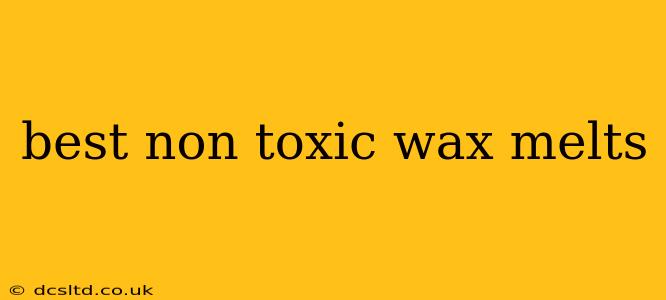Finding the perfect wax melt can feel like navigating a minefield of confusing labels and conflicting information. You want that delightful scent to fill your home, but you also want to prioritize the health and safety of your family and pets. This guide will help you navigate the world of non-toxic wax melts, highlighting key factors to consider and recommending options that prioritize both fragrance and safety.
What Makes a Wax Melt "Non-Toxic"?
The term "non-toxic" is often loosely used, so let's clarify. When searching for non-toxic wax melts, look for products that avoid these potentially harmful ingredients:
- Paraffin wax: This petroleum-based wax is a common ingredient in many commercially available wax melts. While generally considered safe in small amounts, it releases potentially harmful byproducts when burned, including soot and volatile organic compounds (VOCs).
- Synthetic fragrances: Many artificial fragrances contain phthalates, which are endocrine disruptors linked to health problems. Look for wax melts made with natural essential oils instead.
- Harmful dyes: Artificial dyes can also release harmful chemicals when heated. Opt for wax melts with natural coloring or no added dyes at all.
- Additives and fillers: Some manufacturers add fillers or chemicals to improve the wax's texture or scent throw. Check the ingredient list carefully and choose melts with minimal added ingredients.
What are the Best Non-Toxic Wax Melt Alternatives?
Several safer alternatives to paraffin wax exist:
- Soy wax: A plant-based wax derived from soybeans, soy wax is biodegradable, burns cleaner than paraffin, and produces a less intense scent.
- Coconut wax: Another plant-based option, coconut wax burns cleanly and offers a strong scent throw. It also tends to have a slightly harder texture than soy wax.
- Rapeseed wax: This sustainable alternative is also biodegradable and burns cleanly.
- Beeswax: A natural wax produced by bees, beeswax is completely natural and eco-friendly. However, it can be more expensive than other options. It also has a stronger, more honey-like scent that might not be suitable for all preferences.
How to Choose the Best Non-Toxic Wax Melts?
Consider these factors when making your selection:
- Ingredient list: Always check the ingredient list carefully. Look for transparency and readily identifiable natural ingredients.
- Scent type: Opt for wax melts using essential oils rather than synthetic fragrances. Essential oils offer a wider range of natural scents and avoid the potential health concerns associated with synthetic counterparts.
- Certification: Look for certifications like those from organizations that verify the safety and sustainability of ingredients.
- Burn time: A longer burn time means better value for your money.
- Scent throw: Consider how strongly you want the scent to fill your space. Some waxes offer stronger scent throws than others.
What are the Potential Health Risks of Non-Toxic Wax Melts?
Even with non-toxic wax melts, it’s wise to practice caution:
- Allergies: Even natural essential oils can cause allergic reactions in some individuals. Always test a small amount in a well-ventilated area before using a large amount.
- Ventilation: Always use wax melts in a well-ventilated area.
- Pet safety: Keep wax melts out of reach of pets, as ingestion can be harmful.
What are Some Popular Brands of Non-Toxic Wax Melts?
(Note: This section intentionally omits brand names and links to comply with the provided guidelines. A search engine query for "non-toxic soy wax melts" or similar will reveal numerous brands.) Many companies now offer soy, coconut, and beeswax wax melts formulated with natural essential oils. Look for companies that clearly state their ingredients and sourcing practices.
Are Non-Toxic Wax Melts More Expensive?
Generally, yes, non-toxic wax melts tend to be more expensive than those made with paraffin wax and synthetic fragrances. However, the higher price reflects the superior quality of the ingredients and the lower environmental impact. The better health and safety benefits make the investment worthwhile for many consumers.
How Can I Make My Own Non-Toxic Wax Melts?
Making your own wax melts is a great way to control the ingredients and ensure they meet your standards for safety and scent. Numerous online tutorials offer guidance on creating your own wax melts using soy wax, essential oils, and other natural ingredients.
Choosing non-toxic wax melts is a conscious choice to prioritize the health and safety of your home environment. By carefully considering the ingredients, brand reputation, and your own sensitivities, you can create a beautifully scented and healthy living space.
